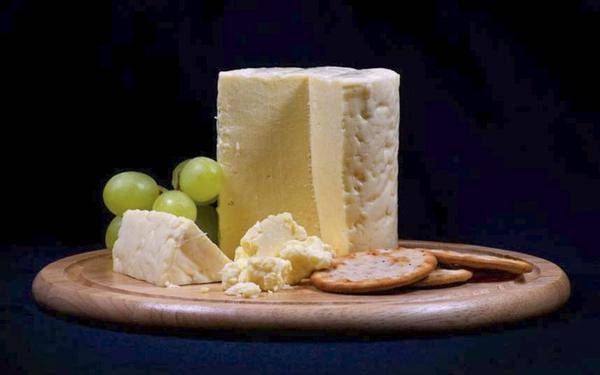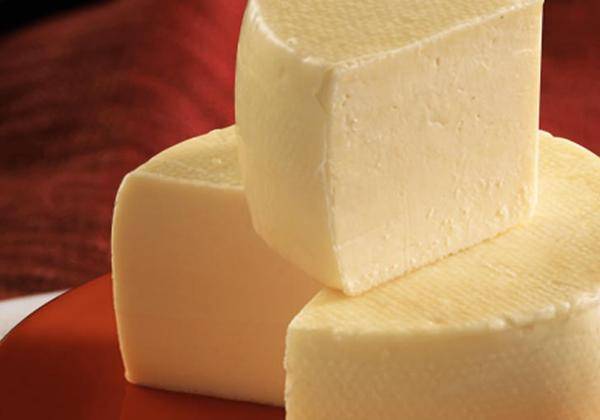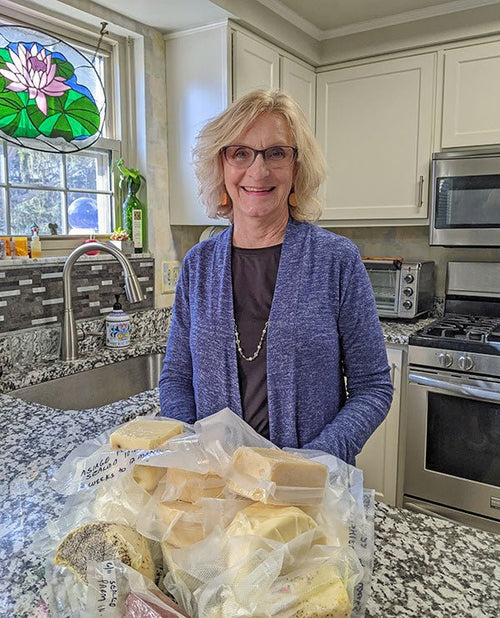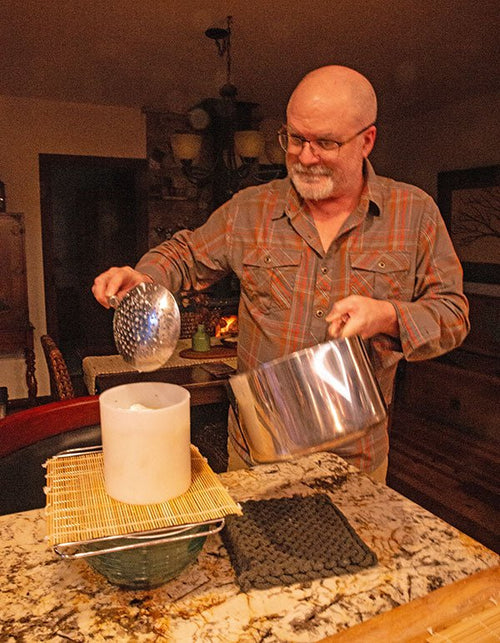Cheese Making Recipe of the Month
Spanish Cheese: Ibores Style
Ibores cheese has PDO status (Protected Denomination of Origin), so it is always made with unpasteurized goat's milk from certain kinds of goats at specific farms in western Spain. It has to be aged for at least 100 days in order to be labelled "artisanal."
One delightful quality of this cheese is the beautiful, ochre-colored rind which has been rubbed with a paste made of smoked paprika and olive oil. The taste of this permeates the cheese as it matures.
You can see from a few of Jim's many pictures below that the process of making the paste and rubbing the cheese is very easy. In fact, with Jim's recipe and pictures, the whole process of making Ibores cheese is simple and fun.
Cheese Making Questions & Answers
Doubling Recipes
Q. I want to double some of the 2 gallon recipes in your book to 4 gallons. Do I just double all of the ingredients?
Are there any precautions I need to be aware of? Do the times stay the same?
A. The increase/decrease in scale is simply a matter of changing the rennet and culture in proportion to the change in milk volume. This does not always scale up/down exactly, so a trial and some corrections may be needed.
Pressing, as given in Ricki’s book, Home Cheese Making is a total weight on the surface of a small 2 lb mold (M3). This is total weight and not pressure.
If using a different mold size, the weight should be changed according to the surface area of the mold. If you use the same diameter mold but add more curds, the weight should not change. If you use a larger/smaller diameter mold, compensate the weight in proportion to the mold surface area.
The area is calculated by using the formula pi x r squared where: r is the radius (r squared is r x r) and pi is a constant of 3.1416.
So, our M3 molds have a radius of approximately 2 inches. 2 squared = 4 x 3.1416 = 12.56 square inches surface area.
The weight applied to our larger (M2) mold with a 7.5 inch diameter is about 3 times greater than our M3 mold which is about 4.25 inches.
Using Goat's Milk
Q. I have a question about the recipe for caciocavallo. I read that it can be made also from goat's milk.
Is there any difference or is there something special to do if goat's milk is used to make caciocavallo?
A. Caciocavallo is usually made with cow's milk but you can certainly use our recipe with goat's milk.
A lot depends on the particular herd, but here are some general considerations:
- Goat's milk takes less rennet, about 25-50% less.
- Raw milk is far more active, of course, and so it needs less culture. This will be true of raw goat's milk and raw cow's milk.
- Goat's milk may require a lower temperature than cow's milk in many cases .
That said, the content of milk changes dramatically during the milking season. After all, the purpose of milk is to feed a baby animal, and as this baby grows, it's nutritional needs change. Summer milk is relatively low in fat content, which shoots up dramatically in the fall. This summer milk is superior to fall milk if you are making hard cheeses (meant to age): high fat content can lead to spoilage issues. Generally, more culture is needed as the solids increase.
All About Ash
Q. I am interested to know about the ASH (activated charcoal) you sell.
In Australia, the ash available for cheese making is very, very fine and powdery and tends to be absorbed by the cheese, particularly in the Morbier style.
I am looking for something with a bit more texture and substance.
A. The ash we source is a fine powdered, activated charcoal. This will neutralize a lot of acid when used on rinds with salt, allowing the surface molds to develop faster. We usually apply this with salt.
The ash is not absorbed into the cheese, so it is often used to form an interior layer midway when ladling lactic curds. The result is a fine black line in the resulting cheese.
The difference between the ash you are referring to (grey) and ours is that grey ash is burned in a surplus of air, whereas our charcoal ash is done at high heat in an anaerobic environment.
Similiar Cultures
Q. The recipe I'm using calls for MA 4001 mesophilic culture. It seems you don't carry that particular one - do you offer a substitute?
A.The MA4000 series consists of a group of cultures (4001, 4002, etc.) that perform in quite the same way. The reason for the series is that a commercial producer using this culture every day may encounter a condition (phage) which prevents the culture from working. By rotating the series, he can avoid this.
Right now, we carry the Large Pack MA4002 in stock. This culture is a combination of mesophilic and thermophilic bacteria which work in tandem for both acidification and aging.
Fiery Ricotta Forte
Q. I have a question about a cheese my Italian grandmother made called Ricotta Forte or Ricotta Scanta. It is the absolute transformation of a mild mannered ricotta into a thick, creamy, spreadable pungent!!!!! cheese that almost delightfully removes the skin from the top of your mouth.
I have been talking to my cousin about this and the Puglian (from Puglia) dialect she spoke. As my cousin remembers it, her word for this cheese essentially means 'ricotta that has spoiled.'
I am making some now in the same container that she used so long ago. I know ricotta is beginning to transform by those first pinkish streaks in the ricotta. I would love to know more about the organism(s) responsible for this transformation.
A. Fromage Forte is sometimes referred to as 'man cheese.' Yes, quite the burn it has!
To make Ricotta Forte (aka 'cheese gone bad'), from scratch, you will be at the mercies of whatever organisms decide to set up housekeeping in/on it:
Likely, the first growth will be a cover of yeast that will quickly turn things into a slimy mess.
With luck, the next growth might be a rosy/orange surface made up of the coryneforms, known for reducing the acidity and making whey for some microbes to follow. These are also the sulfur producing stinkers, so best if they go away soon. Yes! - those first pinkish streaks.
Then, there might be a series of low form white molds, again making the cheese sweeter once they have done their work. The surface is inviting to a mixed bag of molds, yeasts, etc. Depending on the moisture of this writhing mass, changes may take place at varying rates and at varying degrees of sensorial approval. The moisture allows the enzymes produced by the resident microbes to penetrate the cheese; the more moisture, the faster it happens.
The process is all about varying rates of protein and fat breakdown: essentially, the proteins provide the 'aromatics' of rotten eggs and ammonia mostly.
BUT if you really want the FIRE, make sure that the butterfat is not restrained in the ricotta. That picante aspect is the fat breakdown.
The product they sell is the cheese that has broken down inside when the outside is scraped away. The ripening(??) will happen from the surface to the center.
Have a cheese making question, we're here for you: info@cheesemaking.com
Meet a Fellow Cheese Maker
Noreen O'Connell
Milford, New Hampshire
Noreen O'Connell is making her own cheese and selling it at her farm store and at farmer's markets. She is selling out of her goat's milk cheese, yogurt and chevre, so she will be doubling her herd next spring. And this is her retirement job!
Fortunately, her daughter Marcy lives 4 miles away and keeps most of their herd at her farm. Between the two of them, they are currently milking 14 goats. Most of them are Alpine and Nubian crosses - "Nupines."
When Noreen was setting up her make room, she called in the state inspectors for advice. They were very helpful to her and she recommends that approach, when possible.
It has worked out well for her and now her business is booming. She doesn't have time to try new cheeses, but that's alright; her goal is to keep her products simple so she can provide healthy food at reasonable prices. We think that's a great whey to go, don't you?
News From Fellow Cheese Makers
Marinated Cheese Curds
I read with interest Andrew Chisholm's article in the November Moosletter. On our few trips to Canada, my entire family can't wait to cross the border to get a hold of a fresh bag of cheese curds to snack on. Poutine ain't half bad either.
So last weekend, I made the cheese curds with your recipe, and rather than spending a day making french fries and gravy, I went out to our local 5 Guys and got a big bag of fries and made a quick gravy at home. Needless to say, a big bowl of poutine disappeared quickly. Yum!
A problem quickly arose: I had about a pound of cheese curds left over, and I know they lose their squeak after Day 1. So on day 3, I made marinated cheese curds. I made a marinade of olive oil with a little vinegar and added chopped parsley and thyme and minced garlic. I threw in the salted cheese curds and - WOW! A pound of marinated cheese curds gone in an hour - some were thrown in a salad, and the rest eaten out of a bowl by my kid.
Thanks for the recipe!
Bryan Kornreich, Winchester, Virginia
Making Cheese in Cambodia
This is truly a beautiful country and I enjoy being here very much. Bright lush green rice fields spotted with ponds teaming with lotus flowers. The markets are such a feast for the nose and the eyes. There are friendly smiling faces and a warm greetings always follows.
I was introduced to your website a little too late. I ordered your goat cheese kit to my address here in Cambodia before realizing that I cannot get the goat's milk. I will keep looking though. There are a lot of goats running around, but their owners don't milk them.
I do make "Hartmann's Yummy Greek Yogurt" it is plain yogurt that I sell at a local store here in Battambang.
Next week I will promote it in the store and serve the yogurt with Mango chunks. I will also make "Hartmann's Yummy Tzazki." This is my newest product for the store. I'll serve samples with carrots sticks and cauliflower.
Karen L. Hartmann, Battambang, Kingdom Of Cambodia
(Update: After Karen sent us this note, she wrote: "I promoted my Hartmann's Yummy Greek Yogurt and Yummy Tzaziki at a local store here that sells food items for tourists. They also sell some Cambodian foods. I could not get one Cambodian customer to even try it. I had delicious chunks of fresh mango and pineapple in the yogurt. Not one taker." We'll follow up with Karen in next month's issue and maybe that will lead Cambodian cheese lovers to her fabulous products!)
Success in Pakistan
I hope everything is fine at your end. I did not contact you as I was so busy with setting up my cheese plant. Finally it is done and yesterday it was opened for production. We made a successful trial batch with 250 liters (66 gallons) of milk. A dream came true.
Meanwhile, I attended a couple of farmer's markets, having a great response which produced some customers from Italian restaurants. They are my good customers now and order quantities starting from 25kg (55 pounds) at a time.
People related to cheese are getting aware of my company rapidly!
Things are going in the right direction, but managing time is a problem I am facing these days. Being a trader with 2 manufacturing units is not an easy job at all. But, at the same time, I enjoy this labor.
The guy in the picture is my helper, Mr. Shoaib. Three more work as part time jobs and we are producing around 200 kg of mozzarella (441 pounds) and 100 kg (220 pounds) of other types of cheese. This is just a start and I feel excited with the outcome. Customers are just pouring in. Hopefully soon this will turn into my prime business.
Imran Saleh, Lahore, Pakistan,
Please send your cheese making news & photos to: moosletter@cheesemaking.com













































































































































